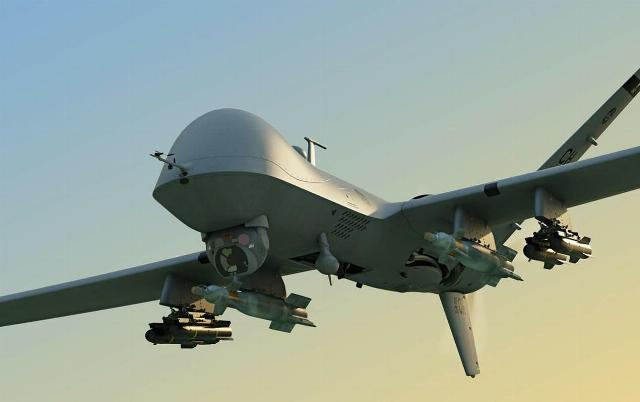The first attack drones — aircraft designed to deliver ammunition and return safely — appeared in the early 2000s. Once again, attack UAVs demonstrated their potential in the Second Karabakh War of 2020. At the same time, their influence on the course of the war in Ukraine turned out to be much more modest. Although Ukrainian attack drones initially achieved some success, their use in countering modern air defense systems was limited compared to small UAVs used in large numbers.
Today, attack drones are available in various configurations, varying in size, speed, range, payload, propulsion system, and launch method. In addition to weapons, they are also equipped with sensors that help detect and destroy targets, as well as perform a second task – to conduct reconnaissance. Each combination of characteristics has unique capabilities that optimize them for different operating scenarios.
Large long-range attack drones can be equipped with an impressive arsenal of weapons and hover over the area of control, identifying potential targets. However, they are more vulnerable to detection by air defense systems and less maintainable than their more compact counterparts. Dozens of new attack UAVs in the world have either recently entered service or are under development.
European-designed attack drones
Jackal (United Kingdom)
The Jackal vertical take–off and landing (VTOL) unmanned aerial vehicle is a product of collaboration between the British company Flyby Technology and the Turkish company Fly BVLOS Technology. It is currently being used as a demonstration sample for the development of a family of unmanned aerial vehicles.
The compact UAV has an unusual configuration that combines structural elements with both a fixed wing and a main rotor. Its wingspan is 5 m and its load capacity is 50 kg. The practical ceiling reaches 3,100 m (although the drone rose 4,000 m during the tests), the flight range is 150 km, and the cruising speed is 222 km/h (120 knots).
The basic UAV can perform logistical, reconnaissance, or combat missions. In the latter mode, the prototype can perform tasks of striking ground targets, as well as conduct aerial combat with helicopters. According to the manufacturer, the Jackal is equipped with Thales light multipurpose missiles (LMM) to combat armored vehicles and helicopters, Thales Free Fall LLM (FFLLM) missiles and Northrop Grumman Hatchet missiles (both are used to combat armored vehicles and manpower).
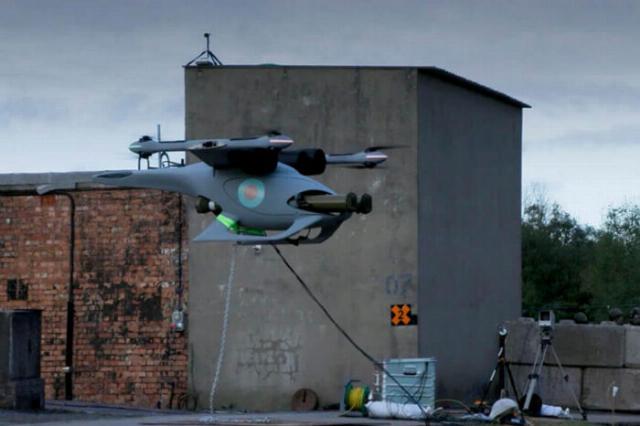
Flyby Jackal Attack Drone with LMM Missiles
The power plant of the demonstration sample consists of four pairs of counter-rotating propellers for vertical takeoff and landing and four electric duct wing propellers (EDFs) for high-speed horizontal flight (an alternative configuration with six EDFs is shown on the Flyby Technology website).
Vertical takeoff and landing technology allows UAVs to be used in confined spaces without runways, including in urban and forest environments, as well as from ships. The plug-and-play modular design is expected to facilitate the development of a family of UAVs capable of providing flexible combat capabilities for the British Armed Forces and its allies.
Hitbird (Germany)
B&S Tech on Target GmbH (Neustadt, Germany) manufactures the Hitbird family of drones, positioning it as suitable for mass production. The Hitbird family of drones was demonstrated at the Eurosatory 2024 exhibition.
The model has an all-metal construction made of aviation aluminum, which ensures the strength of the airframe. The airframe skin and elements can be easily replaced, allowing for quick repair of damaged drones. All Hitbed models are equipped with a single two-stroke piston engine (with a capacity from 5 to 60 hp), which drives the propeller in the nose.
Drones are available in three size categories, which are determined based on their wingspan.:
- Hitbird 175: wingspan 175 cm, dry weight 6 kg, payload up to 5.5 kg;
- Hitbird 350: wingspan 350 cm, dry weight 20 kg, payload up to 29 kg;
- Hitbird 700: wingspan 700 cm, dry weight 60 kg, payload up to 70 kg.

Hitbird 350 Attack Drone
Weapons can be carried inside or on underwing supports. Reconnaissance sensors or guidance sensors for onboard ammunition can be used as a payload.
The maximum speed of all UAV variants is about 200 km/h. The flight range depends on the payload and the amount of fuel, and the user needs to reset some of the available payload in order to reach maximum range. As a guideline, the manufacturer claims a flight range of 1,000 km for the Hitbird 175 with 3.5 kg of fuel, or 840 km for the Hitbird 350 with 17 kg of fuel, or 1,680 km for the Hitbird 700 with 60 kg of fuel.
The Middle East
Golden Eagle Heavy Strike
The Golden Eagle Heavy Strike drone is manufactured by the Israeli company Steadicopter. This is a helicopter-type UAV, first presented at the AUSA 2024 exhibition. Its maximum take-off weight (MVM) is 50 kg, and the payload reaches 15 kg. The drone can be used by ground forces and special operations forces for reconnaissance and precision strikes.
Payload options include Rafael Spike SR and LR2 missiles, suitable for high-precision strikes against armored vehicles, soft and reinforced structures, as well as naval targets. Each UAV carries one missile under its body. Areas of application include armed intelligence, direct air support, border protection, perimeter security, and urban warfare. The rotary design allows the UAV to take off from a limited space. The battery life does not exceed one hour, and the flight range is up to 50 km in the line of sight from the ground control station.
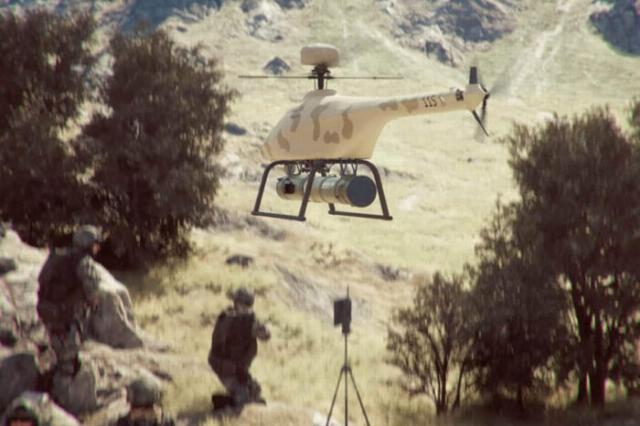
Golden Eagle Unmanned Attack Helicopter with Rafael Spike Missile System
High-resolution onboard optoelectronic sensors are used to detect and track targets, and additional artificial intelligence-based software can also perform target classification functions. The software reportedly allows you to assign an individual identifier to each detected object and ensures continuous tracking, despite temporary obstacles or loss of visibility in the field of view. In addition, it has the ability to "automatically distinguish between different targets, whether they are moving or stationary objects, people or vehicles."
Reach-M UAV
EDGE Group (UAE) unveiled the Adasi Reach-M attack drone at the Dubai Air Show in November 2023. This UAV can stay in the air for up to 24 hours and is optimized for long-term reconnaissance operations and precision strikes against ground targets. The length of the device is 8.7 m, the wingspan is 17 m, and the maximum take–off weight is 1,500 kg.
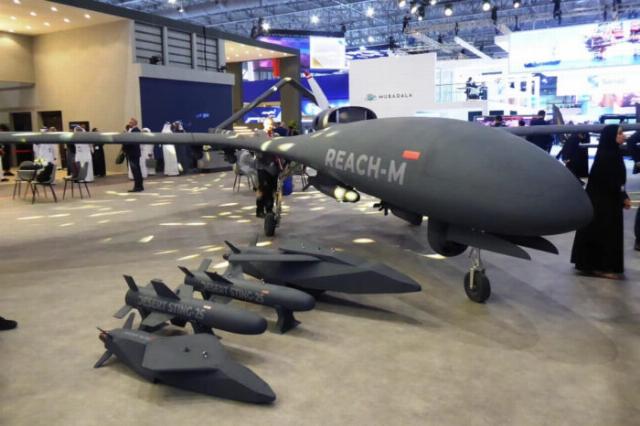
The Adasi Reach-M Attack Drone
The 350 kg payload allows you to carry high-precision and barrage ammunition on seven suspension units. Known payload options include the RASH-3 guided gliding bomb (33 kg caliber) and the Desert Sting-25 guided gliding bomb (47 kg caliber; warhead weight 25 kg).
The Reach M uses a three-bladed pusher propeller with an air intake located on top of the tail section of the fuselage. The cruising speed of the Reach M is 175 km/h, and the practical ceiling is 8000 m. The attack drone uses secure communication channels to receive guidance data and mission updates in real time from the ground control center.
Bayraktar Kizilelma
The Kızılelma UAV of the Turkish company Baykar Technologies is specially designed for aircraft carrier operations, including conducting air, surface and ground warfare. The Turkish Armed Forces plan to deploy a drone on the TCG Anadolu landing ship. It can also operate from short runways on land. Mission control is carried out from a ground station, but it is assumed that Kizilelma will be able to perform many tasks autonomously, including takeoff and landing on a carrier, as well as aerial combat.
The length of the drone is 14.5 m, the wingspan is 10 m. Thanks to its streamlined fuselage, swept wings, front horizontal tail and twin-keeled tail, the Kizilelma jet drone looks like an inconspicuous manned fighter. It is characterized by high maneuverability and low radar visibility.
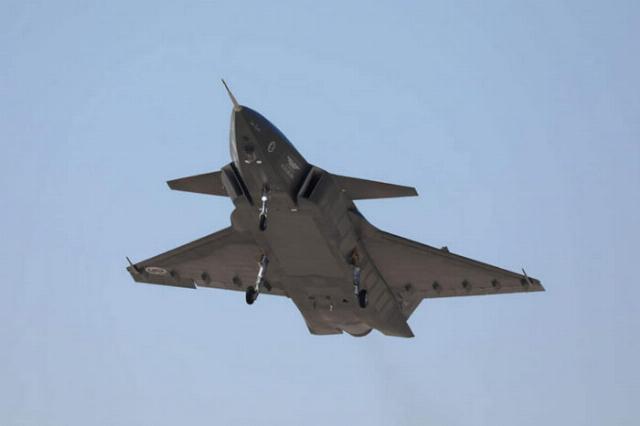
Prototype Bayraktar Kizilelma. March 2023
The maximum take–off weight of the drone is 8.5 tons, and the payload is 1.5 tons. Various types of air-to-ground and air-to-ground ammunition can be used as weapons. The armament is placed both inside the fuselage and on the underwing suspension units. The sensor equipment includes an infrared search and tracking system, as well as an active phased array radar for assessing the air situation and targeting.
Baykar plans to develop three versions of Kizilelma. It is envisaged that the "A" variant will develop a cruising speed of 0.6 Mach and a maximum speed of 0.9 Mach, its practical ceiling will be 13,850 m, and the standard operating height is 7,700 m. The flight duration will be more than three hours. Variants "B" and "C" will develop transonic (usually from 0.8 to 0.99 Mach) and supersonic (>1 Mach) speeds, respectively.
Variants "A" and "B" will be equipped with a single turbofan engine with an afterburner. Option "C" – two engines. Variant A made its maiden flight on December 14, 2022, and completed its 12th flight test on June 17, 2023.
According to the statement of Selchuk Bayraktar, chairman and technical director of Baykar Technologies, made in October 2024, the machine is currently in production, and in 2026 it is planned to release a batch of "more than 10" devices.
To be continued…
Source: euro-sd.com
